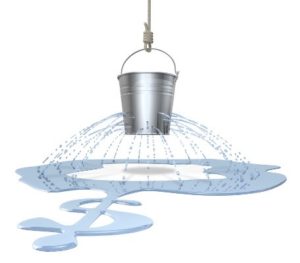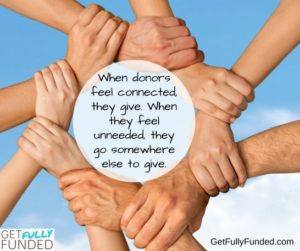There are really only two ways to raise money:
- Ask new people to give to your cause.
- Ask current donors to give again.
Now, the asking can be done through an event, through a grant application, through an appeal, or something else, but it’s always about people.
Seems simple enough, right? Except that it isn’t.
Finding new donors is hard work. It takes time to find ideal prospects, then you have to motivate them to give.
According to the recent Fundraising Effectiveness Project, there’s really bad news:
Most of those new donors that you worked so hard to get won’t ever give again.
In fact, only 23% of a nonprofit’s new donors give again. 
Think about that.
You work really hard to get 100 new donors, and only 23 give a repeat donation.
I know, it sucks.
Now for some good news:
Once people make a 2nd gift, 60% of them will go on to make a 3rd gift.
Which is fascinating.
The key is to get new donors to give again so you can get the repeat donations.
But, how do you do that?
How do you get your new donors AND your current donors to give again?
The answer is simple: connection
How to create connection to fuel repeat donations
 Let me ask you a question: what makes you feel part of something?
Let me ask you a question: what makes you feel part of something?
Whether it’s a club, a church, or some other kind of group, what makes you feel like you belong?
Answering that for yourself will help you give that to your new donors.
And as you’re thinking about it, I’ll share with you what I think it’s about.
Connection is about feeling wanted.
We tend not to stay in groups or relationships that make us feel unwanted. So how do you make donors feel wanted? Thank them well for their donation. Make them the hero for providing the resources needed to change lives. Tell them stories about lives that have been changed because of their generosity. The more you can make them feel wanted and needed, the more likely they are to stick around.
Connection is about authenticity.
Most people want to be with others who are real. We don’t like phonies and fakes. So, be real. Be you. Don’t try to show up as a ginormous organization if yours is a startup and you’re the only employee. It may actually be more attractive to your donors to find out that you’re doing so much with so little. They may see more clearly how their donation will make a difference in a small organization and want to give to help you achieve your mission. Be who you are and own it.
Connection is about communication.
Have you ever had a friend that the only time you heard from them was when they wanted something? Ugh! How frustrating is that? We tend to thank our lucky stars for caller ID so we can avoid that person, right? So don’t be like that with your donors.
Making consistent communication a priority will help you develop deep, lasting relationships with donors. In practical terms, commit to sending a monthly email newsletter. Pick a day (the 5th of the month or the 2nd Tuesday or whatever works for you) and get a meaningful, heartfelt newsletter out, no matter what. If it’s not a priority, then it will drop to the bottom of your ‘to do’ list and never get done.
Don’t forget that good communication goes 2 ways. Think about what you’re doing to invite communication from your donors. Do you give them the name and number of someone they can call if they have questions? Do you give them your email address and invite their feedback? Do you offer tours or an open house so they can see your work for themselves? Even if people don’t respond, they’ll notice that there are opportunities for them to respond and get closer to the organization, and they’ll appreciate it.
Connection is about trust.
We tend to stay in groups that we trust. So, your job is to build trust with donors whenever possible. That means sending out a thank-you letter quickly so they know you’re organized and on the ball (and that you appreciate their donation). It means answering the phone and returning calls promptly (and emails, too). It means being willing to share your financials or answer any questions donors have about where their money went. If you aren’t willing to share, it may appear that you have something to hide, even if you don’t.

Here’s the bottom line: you want repeat donations? Focus on the connection with the donor.
When people feel part of something, they’ll stick around.
When they feel appreciated, they’ll stick around.
When they feel valued, they’ll stick around.
When they feel needed, they’ll stick around.
You might want to evaluate where you’re creating connection with your donors. Make sure you’re helping them feel wanted and that you’re communicating consistently. Make sure you’re being real and building trust. It all matters.
Do the best job you can with these and watch the repeat donations roll in.






Leave A Comment